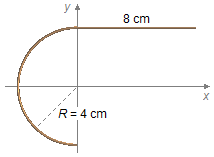Center of Mass
advertisement
We have the following distribution of masses in the xy-plane: m1 = 2 kg at
position (1, -1), m2 = 3 kg at (0, 2), m3 = 1 kg at (-1,0),
m4 = 2 kg at (4, 3) and m5 = 7 kg at (-11, 2). Determine the
coordinates of the center of mass of this distribution and plot a graph.
Two particles, A and B, have masses of 4 kg and 6 kg, respectively. Both move with
constant speeds vA = 5 m/s e vB = 3 m/s such that their directions
make an angle of 60°. Determine:
a) The velocity of the center of mass;
b) The momentum of the system.
a) The velocity of the center of mass;
b) The momentum of the system.

A semicircular arc of radius R has the center of mass at a distance
\( \frac{2R}{\pi} \)
from the center. Determine the position of the center of mass, of a wire homogeneous and a constant
cross-section with the shape shown in the figure, relative to the cartesian system given.

A man of mass m is sitting on the stern of a resting boat in a lake. The mass of the boat is
M = 3m, and its length is L. The man rises and walks toward the bow. Neglecting the
water resistance determine the distance D that the boat travels when the man walks from the stern
to the bow.

From the opposite sides of a platform of length L, resting on frictionless rollers, an adult and a
child are running toward each other. Determine how far the platform will slide when the adult moves from
one end of the platform to the other. We know that the speed of the adult is twice the speed of the child,
and the masses of the platform, the adult, and the child are m1, m2 and
m3, respectively.
advertisement

Fisicaexe - Physics Solved Problems by Elcio Brandani Mondadori is licensed under a Creative Commons Attribution-NonCommercial-ShareAlike 4.0 International License .